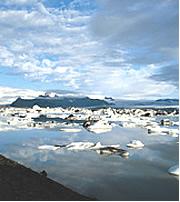 You have to be fit or fat - or both - to survive a dip in the Antarctic.© Getty
You have to be fit or fat - or both - to survive a dip in the Antarctic.© GettyBritish swimmer Lewis Pugh this week broke two world records, for the most southerly swim ever undertaken in the ocean, and the longest-duration polar swim ever completed. In completing the two feats, he battled temperatures that would kill you or me in minutes. So what does he have that we mortals don't?
On 14 December, Pugh swam a kilometre in the seas off the Antarctic Peninsula at a latitude of 65º South, some of the world's coldest waters, where the sea's saltiness allows temperatures to dip to just below 0 ºC without freezing. The feat, which took 18 minutes and 10 seconds, required him not only to maintain a safe body temperature throughout the ordeal, but also to stave off the crippling effects of the body's natural reaction to icy water.
Two days later, he swam a mile off the nearby Deception Island, spending 30 minutes and 30 seconds in the water - longer than any other polar swimmer. Physiologist Tim Noakes of the University of Cape Town, South Africa, who accompanied Pugh on the trip, said: "I did not believe it possible to swim for 30 and a half minutes in 2-3 ºC water in just Speedo trunks."
"Normal people would probably be dead within a minute because of the cold-shock reflex," says James Butcher of British medical journal The Lancet1, which profiled Pugh ahead of his record attempt. Less than a second after hitting the water, the lungs constrict, causing an untrained person to hyperventilate, taking up to 60 gasping breaths per minute. Heart rate and blood pressure also skyrocket as the heart panics in response to the shock. Pugh says he felt "screaming pain" all over his body as soon as he dived in.
"It's an exaggerated fight-or-flight response," explains exercise physiologist Michael Tipton of the University of Portsmouth, UK. The paralysing effect of this response means that, in icy water, the body becomes its own worst enemy; not that this is typically a problem. "In our normal day-to-day experience, we don't tend to fall into cold water," Tipton points out.
Cold shower
Fortunately for Pugh, overcoming the response is fairly easy. "Anybody can develop a habituation to the cold," says Tipton. "You can do it with as little as five or six 5-minute immersions."
Tipton and his colleagues have found that, with enough exposure to cold water, volunteers can even be trained not to shiver, allowing muscles to work more effectively. In the weeks leading up to his swim, Pugh took frequent cold showers as well as training in icy water.
“The thing that keeps him going is the ability to produce large amounts of heat.”
Michael Tipton
University of Portsmouth
Of course, preventing the body from shutting down is just half the battle - Pugh and his support team also had to ensure that his body temperature remained above 35 ºC, which is generally regarded as the cut-off point for hypothermia. "The thing that keeps him going is the ability to produce large amounts of heat," Tipton says.
Pugh is aided in this by what Noakes calls 'anticipatory thermogenesis'. Just the sight of icy water is enough to send his body temperature ratcheting up to 38 ºC, giving him a head-start against the ravages to come.
"Mental imagery can have a profound effect on physical responses," says Tipton. The same thing happens on a smaller scale when the average person anticipates giving a speech, for example, as their body releases stress hormones and ups its metabolic rate.
Fit or fat
ADVERTISEMENT
Once in the water, the best way to maintain body heat is to produce a lot of it through frantic swimming, and to stay well insulated. The best long-distance swimmers tend to have a combination of these "fitness and fatness" factors, Tipton says.
Women tend to be relatively better than men at outdoor swimming, because their tendency to have more fat over their leg and arm muscles keeps them better insulated. This is important during active swimming, when blood is pumped into the arms and legs and so can accelerate heat loss. The previous record-holder for polar swimming is US female Lynne Cox, who has attributed her success in part to her 36% body fat (most women have a percentage in the 20s).
But thinner men and women can gain back an advantage by being fit. "If you see a thin outdoor swimmer, the chances are they're really fast," says Tipton. Pugh falls into this category. Besides his record as the only person to have swum at both ends of the Earth, he is also the fastest man to swim around South Africa's Robben Island, completing the circuit in just three hours and 42 minutes in 2004.
University of Portsmouth
